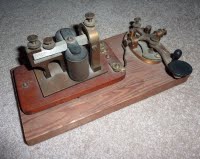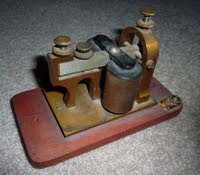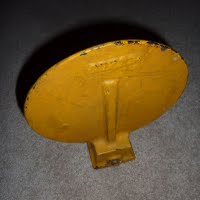TRHA Artefacts: The Victorian Internet, Sounders & Keys


 Click on each image for a closer look!
Click on each image for a closer look!.
One of my favourite books is called the "Victorian Internet" which was written by Tom Standage. Here is an excerpt from the author's website about this book:
"In the nineteenth century there were no televisions, aeroplanes, computers, or spacecraft; neither were there antibiotics, credit cards, microwave ovens, compact discs, or mobile phones.
.
There was, however, an Internet.
.
During Queen Victoria's reign, a new communications technology was developed that allowed people to communicate almost instantly across great distances, in effect shrinking the world faster and further than ever before. A world-wide communications network whose cables spanned continents and oceans, it revolutionised business practice, gave rise to new forms of crime, and inundated its users with a deluge of information. Romances blossomed over the wires. Secret codes were devised by some users, and cracked by others. The benefits of the network were relentlessly hyped by its advocates, and dismissed by the sceptics. Governments and regulators tried and failed to control the new medium. Attitudes to everything from news gathering to diplomacy had to be completely rethought. Meanwhile, out on the wires, a technological subculture with its own customs and vocabulary was establishing itself. The telegraph unleashed the greatest revolution in communications since the development of the printing press. Modern Internet users are in many ways the heirs of the telegraphic tradition, which means that today we are in a unique position to understand the telegraph - and the telegraph, in turn, can give us a fascinating perspective on the challenges, opportunities and pitfalls of the Internet."
.
The telegraphs systems developed at about the same time as development of the railways exploded in the late 1800's and the early 1900's. The natural land route for the poles and wires that carried the telegraph signals was along the railway right of ways. The telegraph provided railways the means of communicating between stations to control traffic. The railways also provided the public with telegraph services.
.
For more information about the history of telegraphy, visit this Wikipedia entry.
.
The TRHA has begun to acquire telegraphy artefacts. Pictured above are two "sounders" and a "straight" telegraph key recently donated by Dave Best of Kingston, Ontario. Telegraph keys were used to produce the "dots" and "dashes" used in Morse Code to send the characters in a message to others on the network. The Sounder turned the electrical signals into an audible sound to allow the telegraph operator to hear the dots and dashes and write down the message.
.
The final picture above shows a third artifact donated by Dave Best to the TRHA. This an indicator head for a switch stand.
.
Posting and Pictures by Russ Milland






<< Home